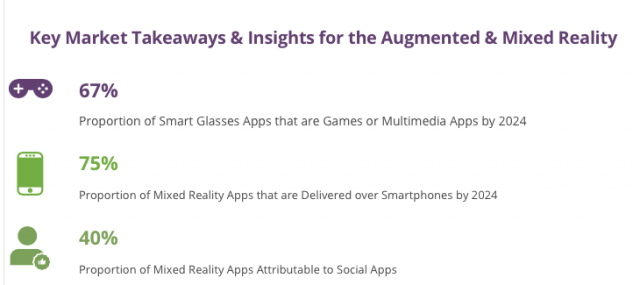In case you missed it, in the latest worldwide VR – AR (virtual reality – augmented reality) market forecast, spending is reckoned to increase 78.5% next year, reaching $18.8 billion in 2020, over the $10.5 billion in 2019. The prediction is made by IDC (see below).

But a new report from Juniper Research out of the UK puts a different spin on the market seeing a break-out in the mobile “mixed reality” segment market place with emphasis on mixed reality services that Juniper said has already claimed the lion’s share, some $8 billion of the 2019 AR – VR dollars in 2019 alone. That sector alone is expected to grow to $43 billion by the end of the 5 year study period (2024.) Juniper sees the space as a potential disrupter with focus moving from standalone VR headsets to existing smartphones, tablets and eventually smart glasses.
The new Juniper research, Augmented & Mixed Reality: Impact Assessments, Sector Analysis & Forecasts 2019-2024, identified 5G networks and edge computing (see whitepaper) as two key enabling technologies that will accelerate the development of mixed reality services in 2020.
 Augmented Mixed reality: impact assessments, Source: Juniper research 2019
Augmented Mixed reality: impact assessments, Source: Juniper research 2019
In the mobile “mixed reality” market place where real world objects are not simply overlaid with digital (virtual) data, but combine and interact with objects in the real world. The advent of 5G and supportive Edge computing networks are pushing the service technology forward. Here’s an excerpt from the original edge computing white paper from the ETSI, (European Telecommunications Standards Institute):
Mobile Edge Computing opens up services to consumers and enterprise customers as well as to adjacent industries that can now deliver their mission-critical applications over the mobile network. It enables a new value chain, fresh business opportunities and a myriad of new use cases across multiple sectors. The intention is to develop favourable market conditions which will create sustainable business for all players in the value chain, and to facilitate global market growth. – ETSI
In short, Juniper is looking to the mixed reality market and a “second wave” of smartglasses adoption by increasing the end users’ capabilities, leveraging the “nearly 6 billion smartphone users, combined with established content distribution in the form of app stores, to drive mixed reality content development to smartphone devices. The research reckons 75% of consumer mixed reality will be attributable to smartphone apps by 2024.
 VR-AR-Mixed Reality progression, source: Julia-Tokareva, aniwaa.com
VR-AR-Mixed Reality progression, source: Julia-Tokareva, aniwaa.com
This interactive component of the technology also recently received a boost when Oculus CEO Mark Zuckerberg announced its newest stand-alone headset (Oculus, Quest) in October. It will ship with wireless hand-gesture control in early 2020 (see the Quest video here). The headsets are still rather clunky, and it’s difficult to imagine broad consumer adoption, yet deployment of free hand gesture technology in the space is a big step in the right direction.
So while the IDC Research expects to see continued AR-VR growth in the commercial sectors, with “…its combined share of overall spending grow from less than 50% in 2020 to 68.8% in 2023,” Juniper is looking to the mixed reality market and a “second wave” of smart glasses adoption and the rise of consumer use from new services enabled by 5G and Edge computing. We’ll soon see. Stephen Sechrist
Augmented/Virtual Reality in Healthcare, a Success Story?
Augmented Reality and Virtual Reality Swaying Casino Gaming Market
IDC Expects Asia/Pacific* Augmented and Virtual Reality Spending to Reach USD 70.2 Billion in 2023

